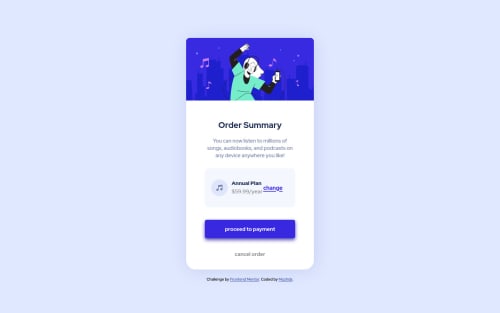Order Summary Component Using HTML & CSS.

Solution retrospective
Feedback of any kind would be greatly appreciated :)
Please log in to post a comment
Log in with GitHubCommunity feedback
- @MuzhdaN
@Kareemah-codes There have been some minor but crucial points raised by you. I will keep your advice in mind when I work on my next project :)
p.s Definitely, I will take a look at your projects as well.
- @Kareemah-codes
Thank you!
- @Kareemah-codes
Hello, so I have a few pointers if I may:
-
Try using semantic HTML, going to your code there is just a lot of divs in places that could be semantic. For example, instead of using divs for buttons, you could just use your button tag. It offers the same functionality but is just a bit more readable. Semantic HTML is also best for accessibility purposes. You could dedicate two hours tops to learning it, it's really not that difficult.
-
Asides from that, I think you are good to go. If I wanted to get nitpicky, I would say that the space between the "annual plan" area is too close to the "change" area. I looked through your code and it looks to me like you made a mistake in the divs. There is a div whose class is "left-part", I am guessing change is supposed to be in a div with a class "right-part" so that you can properly space them out. I may be wrong though.
I am a beginner, kindly consider giving me feedback on the projects I have completed. I would really appreciate it.
-
Join our Discord community
Join thousands of Frontend Mentor community members taking the challenges, sharing resources, helping each other, and chatting about all things front-end!
Join our Discord